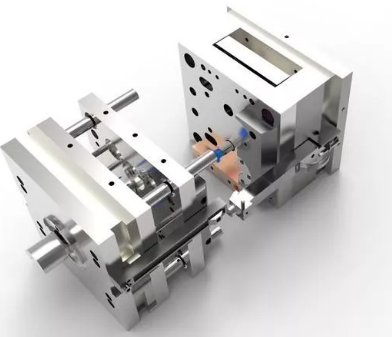Hey there! You’re in the right place if you’re curious about how manufacturers create various parts and products, especially using injectionyou and stamping dies. These two tools play essential roles in manufacturing, but they work pretty differently. LLet’sdive in and compare the details to understand their unique characteristics and applications.
I. Different Forming Principles
1. Forming Principle of Injection Molds
Injection molding is like baking a cake. You start by melting plastic pellets until they’re nice and gooey. Then, this molten plastic is injected into a mold (think of it like a cake pan), and it cools and hardens into its shape. The process involves clamping the mold shut, injecting the plastic, cooling it down, and finally popping out the finished product. This method is perfect for making complex and precise plastic parts.
2. Forming Principle of Stamping Dies
On the other hand, stamping is more like using a cookie cutter on dough. You take a flat sheet of metal and place it in a press. The press uses a tool and die to shape the metal into the desired form. This can include cutting, bending, and shaping the metal sheet. Stamping is great for producing metal parts with consistent dimensions and is super efficient for mass production.
II. Different Types of Formed Products
1. Products Formed by Injection Molds
With injection molding, you’re looking at creating plastic products—these range from tiny gears and screws to more oversized items like car dashboards and appliance housings. The process allows for intricate shapes and high precision, making it a go-to for automotive, medical, and consumer electronics industries.
2. Products Formed by Stamping Dies
Stamping dies are used to make metal parts. Think automotive body panels, electrical components, brackets, and various hardware. Stamping is ideal for large quantities of uniform parts, making it essential in the automotive, aerospace, and electronics sectors.
III. Structural Differences in Molds
1. Main Structure of Injection Molds
Injection molds consist of two main halves: the core and the cavity. These molds are designed to handle high pressure and temperature. The vital components are the mold base, cavities, cores, cooling channels, ejector pins, and gating system. Precision is critical to ensuring high-quality plastic parts with minimal defects.
2. Main Structure of Stamping Dies
Stamping dies are built to withstand the force of shaping and cutting metal sheets. The main parts include the die block, punch, stripper, and bolster plate. Dies can be single-stage or progressive, with the latter performing multiple operations in one go. The robustness of these dies ensures consistent production of metal parts.
3. Structural Differences Between Injection Molds and Stamping Dies
Injection molds require cooling systems and precise cavities for molten plastic. Stamping dies, in contrast, handle the force of metal shaping, necessitating robust construction and sharp cutting edges. These differences cater to their specific forming principles and product requirements.
IV. Different Materials Used
1. Standard Materials for Injection Molds
Injection molds are made from hardened steel, pre-hardened steel, aluminum, and beryllium-copper alloy. The choice depends on production volume, part complexity, and plastic-type. Hardened steel is durable for high-volume production, while aluminum is cost-effective for prototypes.
2. Common Materials for Stamping Dies
Stamping dies use tool steel, carbon steel, and sometimes carbide. Tool steel is hard and wear-resistant, ideal for high-impact metal stamping. Carbide, though expensive, offers superior durability and precision, perfect for high-volume settings.
V. Differences in Production Processes
1. Injection Molding Process
The injection molding process involves:
- Clamping: The mold is clamped shut.
- Injection: Molten plastic is injected into the mold.
- Cooling: The plastic cools and solidifies.
- Ejection: The finished part is ejected.
This cycle can vary in time depending on the material and part complexity, but it generally ranges from a few seconds to a few minutes.
2. Stamping Process
The stamping process includes:
- Blanking: Cutting the metal sheet into the desired shape.
- Forming: Shaping the blanked piece using dies and presses.
- Trimming: Removing excess material.
- Finishing: Additional processes like deburring or coating.
Stamping is rapid, producing a high volume of parts quickly, making it cost-effective for large-scale production.
VI. Different Application Fields
1. Main Application Fields of Injection Molds
Injection molds are used in industries needing high-precision plastic parts:
- Automotive: Dashboards, lighting fixtures, and engine components.
- Medical: Syringes, inhalers, and diagnostic devices.
- Consumer Electronics: Casings, connectors, and internal components.
2. Main Application Fields of Stamping Dies
Stamping dies are crucial in industries needing metal parts:
- Automotive: Body panels, brackets, and engine components.
- Aerospace: Structural components and assemblies.
- Electronics: Metal connectors, enclosures, and frames.
So, while both injection molds and stamping dies are essential in manufacturing, they cater to different materials and applications. Knowing their unique characteristics and applications helps you choose the right tool for your production needs, enhancing efficiency and quality.

